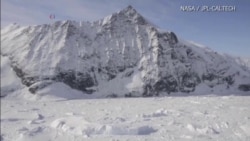A huge section of Antarctica’s ice shelf is rapidly thawing, according to a just-released study by the U.S. National Aeronautics and Space Administration.
The loss of ice from polar caps is slowly but steadily raising the level of the Earth’s oceans, scientists say. They predict it will be only a few years before the Larsen B Ice Shelf – at 1,600 square kilometers or almost 618 square miles – completely disengages from the ground and breaks into hundreds of icebergs.
Two-thirds of the 10,000 year-old shelf is already gone, said Ala Khazendar, the study’s lead scientist. "This is a clear indication of the enormity of changes that are taking place in the Antarctic Peninsula and elsewhere in Antarctica," he said.
Ice shelves are giant frozen platforms that hang over the edges of the Antarctica continent, supported by ocean water below. The largest of them is almost as big as France.
Khazendar said three glaciers that supply the Larsen B shelf with ice are thinning and gaining speed.
"From our study, now we know that these glaciers are flowing faster and most likely they are putting more ice into the ocean," said Khazendar, who led a team at NASA’s Jet Propulsion Laboratory in Pasadena, California.
Using sophisticated airborne instruments, including radar, scientists already have noticed new cracks in the ice that were not there when they submitted their findings nine months ago.
The disintegration is “happening fast and it's just a matter of years,” Khazendar said.
The study was published in the journal Earth and Planetary Science Letters.








